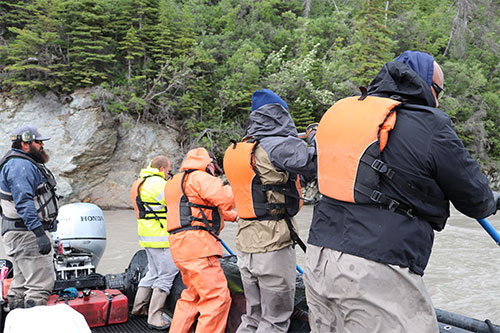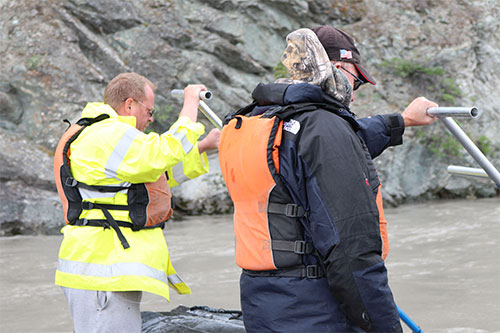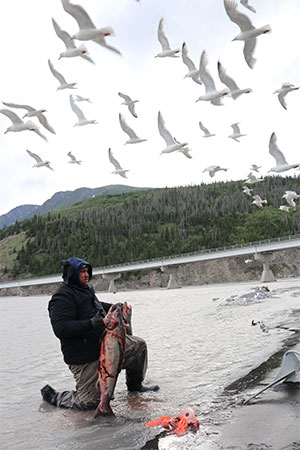
The Salmon StateLow Copper River sockeye return effects ripple outwardDipnetters optimistic; ADF&G making decisions ‘week-by-week’By MARY CATHARINE MARTIN
July 17, 2018
It’s a tradition, however, that many won’t fulfill this year, with personal use fisheries largely shut down for the first time since statehood. Many locals and dipnetters on the river are optimistic that the fish are coming, but late. Alaska Department of Fish & Game managers don’t believe that’s the case, but, based on recent sonar counts at Miles Lake, downriver of Chitina, they did on July 16 announce the second 84-hour opener in a two-week period.
On July 8 and 9, however - normally a busy time of year in Chitina - the campgrounds were almost empty, the streets were quiet and the only charter business running was AK eXpeditions, a Zodiac-based dipnetting charter and tour company owned and operated by Mark Spencer, who has permits to run his boats in the subsistence area above the Chitina-McCarthy bridge. On the water Spencer started guiding on the Kenai, but would come to the Copper River to fish for his own freezer. When his clients learned that, they were interested in coming along. Now, it’s his fifth season guiding on the Copper. “I always kind of envision this is how Alaska used to be,” he said, comparing the Copper River to the Kenai. “There aren’t so many people here, and the river keeps the traffic in check.”
Spencer let me tag along with Tasi Fosi of Anchorage, Al Myers of Fairbanks, Dave Osantowski of North Pole, and John Naylor of Wasilla as he took them out on the water the afternoon of July 9 to try their luck. Most of them had been coming to Chitina for years, though it was also the first time most of them were dipnetting the Copper from a boat. Last year, Naylor said, he caught 30 reds and one king fishing from one of Spencer’s Zodiacs. “It’ll be slow, slow, slow, and then you’ll find a run… and just hammer it,” he said. This year, the four men caught eight kings and one red between them all. Naylor expressed the optimism that many Chitina residents felt: “I don’t think they’re not here,” he said. “I think they’re late.” Another who expressed optimism was 79-year-old Ahtna elder Martin Finnesand, born in Chitina, who has fished all his life. 2018’s poor returns, Finnesand said, stand out. In 1957, he was seining in Cordova, at the mouth of the Copper River. At the time, people said was the worst since 1932, he remembers. Finnesand has a fish wheel he operates every few years, harvesting around 100 fish each time through his state subsistence permit. So far this year he’s on track. Given a recent jump in Miles Lake sockeye counts - from a low of 2,503 on July 11 to a high of 21,536 just three days later, on July 14 - he doesn’t expect any problems.
Local effect Long-time business Hem Charter, owned by Mark Hem, has a permit only for the personal use area, downstream of the Chitina-McCarthy bridge. The business, which he’s been operating for 35 years, has for the most part been shut down this year. “Everyone is bummed. We live and die by the fish here in Chitina,” agreed Mary Emerson, bartending at Uncle Tom’s Tavern. Chitina has experienced other difficulties this year as well, one of them a flood that washed out several camp spots, signage, and parking at the Native corporation’s O’Brien Creek campground - not to mention accompanying high water on the Copper, which makes it yet harder to catch fish. Chitina Native Corporation CEO Ed Herndon said the corporation and town have had to “hold back on some regional development projects and cut back on other in-town expenses” because of low campground use, land and recreational use permit purchases, and other effects of the low runs.
“We are truly hoping that the fish will show and this is just indicative of a late run,” he wrote in an email. “It’s not only the corporation, it’s the whole community of Chitina,” added Chitina Native Corporation business manager Jeff Doty. “Up the road to Kenny Lake, it’s the same way.”
Even Spencer, who has been able to operate AK eXpeditions on the Copper some this summer, estimates he’ll only break even this year. Operating a charter business is a major investment — from boats, to employees, to dipnets. But, Spencer said, “the biggest asset we have is salmon. Without salmon, all this is for naught.” Reds and kings ADF&G area management biologist Mark Somerville said they’re managing the fishery week by week, taking into account the sonar accounts at Miles Lake and an array of other information. “Can we even afford to have a harvest there?” he asked rhetorically on July 12. “That’s what we’re managing the fishery for now.” In spite of the optimism many in Chitina expressed about a late run, Somerville said that while managers hoped, at the beginning of the season, that sockeye were just late, that’s no longer a likely theory. Though counts at Miles Lake are up, there are two important caveats. The first is that the numbers at Miles Lake count hatchery fish, not just wild fish. The second is that while the cumulative count isn’t far below last year’s, last year, there was also a commercial fishery. They’ve been looking at a lot of potential reasons for the low red return, Somerville, said, including the warmer water in the Gulf, the weather, and the way the parent stock in 2013 was harvested. One commonality for the returning Copper River reds: they’re smaller than they should be. Another element of the mix: while sockeye are doing poorly on the Copper, the river is one of the only ones in the state that is having a better than expected return of king salmon. “Even if we had a commercial fishery, we’d still have a pretty good run of (kings) this year,” Somerville said. Kings have so far exceeded their forecast of 43,000, even with a small commercial harvest. It’s something he called “a bit of a shocker” given the dismal returns of king salmon on most other Alaskan rivers this summer. All in all “it’s a bit baffling,” Somerville said. “It will take a while to figure out.”
Representations of fact and opinions in comments posted are solely those of the individual posters and do not represent the opinions of Sitnews.
|
||||||||




